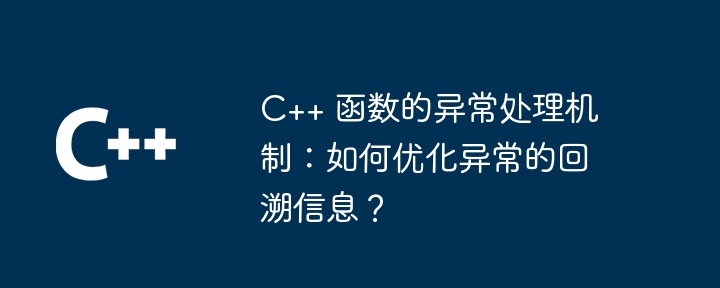c++++ 异常处理机制的优化措施包括:使用 noexcept 关键字避免生成异常处理代码,提升性能。链式异常添加附加信息,丰富异常回溯。创建自定义异常类存储特定信息,跟踪异常来源。

C++ 函数的异常处理机制:优化异常的回溯信息
在 C++ 中,异常处理是一种重要的机制,用于处理程序执行过程中的异常情况。当发生异常时,程序会从抛出异常的点开始回溯函数调用栈,以确定异常的根源。为了增强异常回溯信息的实用性,我们可以采取一些优化措施。
优化方法:
立即学习“C++免费学习笔记(深入)”;
noexcept 关键字:int divide(int numerator, int denominator) noexcept {
if (denominator == 0) {
throw std::runtime_error("Division by zero");
}
return numerator / denominator;
}noexcept 关键字指示编译器该函数永远不会抛出异常,从而避免为该函数生成异常处理代码,优化回溯信息的性能。
try {
try {
throw std::runtime_error("Inner exception");
} catch (const std::exception& e) {
throw std::runtime_error("Outer exception: " + e.what());
}
} catch (const std::exception& e) {
std::cerr << "Caught outer exception: " << e.what() << std::endl;
}链式异常允许在捕获异常时添加附加信息,丰富回溯信息的内容。
创建自定义异常类允许我们存储有关异常的特定信息,从而更好地跟踪异常的来源。
class CustomException : public std::exception {
public:
CustomException(const std::string& message) : message_(message) {}
const char* what() const noexcept override { return message_.c_str(); }
private:
std::string message_;
};使用自定义异常:
try {
throw CustomException("Error occurred in function foo");
} catch (const CustomException& e) {
std::cerr << "Caught custom exception: " << e.what() << std::endl;
}实战案例:
考虑以下函数:
int calculate(int x, int y) {
.... // 复杂计算
if (condition) {
throw std::runtime_error("Calculation error");
}
return result;
}通过应用优化措施,我们可以丰富异常回溯信息:
noexcept 优化对 calculate 函数的部分计算过程,提高性能。CalculationException,存储有关计算错误的特定信息。int calculate(int x, int y) noexcept {
.... // 优化部分计算
try {
if (condition) {
throw CalculationException("Calculation error in calculate");
}
} catch (const std::runtime_error& e) {
throw std::runtime_error("Calculation error: " + e.what());
}
return result;
}通过这些优化,异常回溯信息变得更具信息性和可操作性,帮助我们更快地识别和解决异常的根源。
以上就是C++ 函数的异常处理机制:如何优化异常的回溯信息?的详细内容,更多请关注php中文网其它相关文章!

每个人都需要一台速度更快、更稳定的 PC。随着时间的推移,垃圾文件、旧注册表数据和不必要的后台进程会占用资源并降低性能。幸运的是,许多工具可以让 Windows 保持平稳运行。

Copyright 2014-2025 https://www.php.cn/ All Rights Reserved | php.cn | 湘ICP备2023035733号